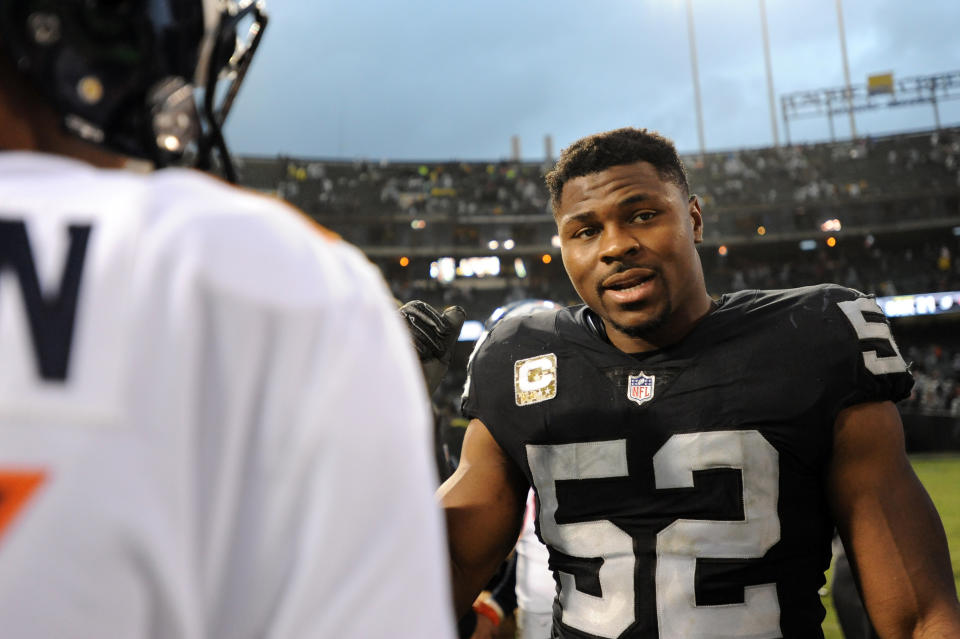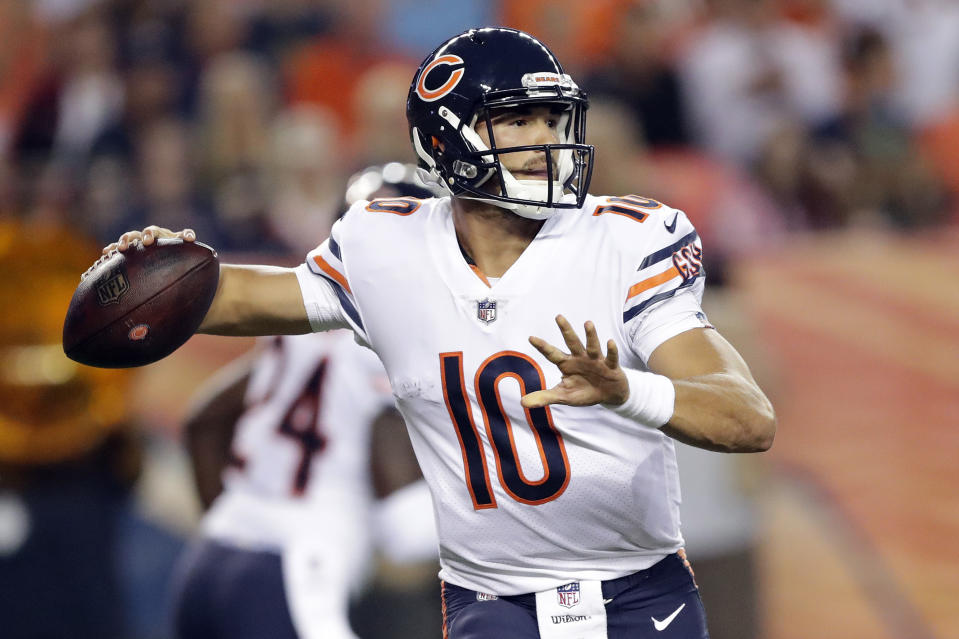Bears' trade for Khalil Mack is bold and smart, but comes with heavy financial risk
When the Chicago Bears decided to break Twitter on Saturday morning by trading for Oakland Raiders star edge rusher Khalil Mack, there was a rush by many to crown the Bears for general manager Ryan Pace’s bold move. And on the surface, it’s easy to understand why.
From the Bears’ perspective, even though they’re reportedly surrendering two first-round picks for the right to make Mack the NFL’s highest-paid defensive player, it’s clear the Bears, who haven’t had a winning season since 2012, are trying to speed up their timeline.
And considering they currently employ one of the league’s best defensive coordinators in Vic Fangio, who managed to scheme the Bears to 42 sacks in 2017 – the seventh-most in the league — without any Pro Bowlers on that side of the ball, there’s little doubt a premium edge rusher like Mack will do wonders.

How the Bears got better end of this deal
Mack essentially gives the Bears’ defense a much-needed face, and given the attention he’ll command, his presence should make life a little easier for fellow edge rusher Leonard Floyd, a 25-year-old former first-round pick who will be expected to do more after recording a combined 11½ sacks his first two seasons. If Floyd comes along as expected, that will give Chicago the fearsome edge rush necessary to compete in a division where strong quarterbacks (Green Bay’s Aaron Rodgers, Detroit’s Matthew Stafford and Minnesota’s Kirk Cousins) lie at every turn.
From the Raiders’ perspective, obviously they’re thinking … well, as Harry Doyle from “Major League” might say, I don’t know what the hell they’re thinking. Mack is 27, and three-time Pro Bowlers and two-time All-Pro players at that age aren’t easy to come by. What’s more, Mack was a team captain with the Raiders, so he’ll bring that element to the Bears, too.
Yet, the cash-strapped Raiders — who only have $7 million in salary-cap room this year — didn’t bother to offer Mack a contract extension, and instead chose to take two lottery tickets disguised as first-round draft picks and save about $23 million per year for the foreseeable future in lieu of helping Mack break the bank.
So yes, the Bears appear to be getting the better end of this deal. They’re the ones getting the stud at a premium position who won’t turn 28 this year, which historically tends to be a pass rusher’s best statistical season. If you’re Chicago, you do this deal every day and twice and Sunday.
However, there’s still some significant risk involved for the Bears, and that needs to be acknowledged.
Here’s the risk for Bears in Mack trade
The Bears’ biggest problem last year wasn’t their defense, it was their miserable offense, which ranked 30th in yards per game and 29th in points.
Pace tried to rectify that this offseason by hiring Kansas City Chiefs offensive coordinator Matt Nagy, a bright offensive mind with a fondness for the spread game who is unafraid to push the limits of run-pass options and hurry-up football. He’ll tailor an offense suited to second-year quarterback and former No. 2 overall pick Mitchell Trubisky, and given the offensive weapons Chicago added to the mix this offseason — including receiver Allen Robinson and tight end Trey Burton — there’s a reasonable chance the Bears will improve on that side of the ball.

However, the trade puts a lot of pressure on Trubisky and Nagy, who must now get the offense up to speed quickly in a tough NFC North that features two strong candidates to make the playoffs in Minnesota and Green Bay, and a Detroit team that has hovered around .500 for the better part of five seasons.
I have no doubt Nagy will get things turned around in Chicago, but at the outset, the Bears’ offense will need to make marked improvements to avoid surrendering a top-10 pick in the deal, which — in an age where player salaries are exploding — is one of the best, and most-efficient, assets in pro football. Teams that hit on those picks get a really good player on a cost-efficient deal for at least four years and maybe seven, depending on if a team exercises its options.
Again, I don’t mention any of this to diminish the trade from Chicago’s part; this was a worthy gamble by the Bears, who later on Saturday reportedly agreed to a six-year extension with Mack valued at $141 million. But when you add all that to the fact the history of elite pass rushers being traded doesn’t always work out for the acquiring team, and there is some reason for caution.
What history says about dealing for elite pass rushers
While reasonable men would agree that the Falcons’ trade for John Abraham in 2006, the Vikings’ deal for Jared Allen in 2008 and the Cardinals’ acquisition of Chandler Jones in 2016 all worked out for those teams — all played so well that there was no gnashing of teeth over the picks surrendered in those deals — one can go back to 1993 to see the absolute worst-case scenario.
That year, the Lions — believing they were only a pass rusher away from contention — traded a 1994 first-round pick and a 1994 fourth-round pick to New Orleans for 29-year-old star edge rusher Pat Swilling.
Swilling is a man who has been lost to time a bit, but in his day, he was a monster. In 1993, he was coming off his second straight first-team All-Pro nod at outside linebacker — ahead of eventual Hall of Famer Derrick Thomas — and was only two years removed from winning the NFL’s defensive player of the year award.
The Lions even unretired No. 56 — the number that team legend and Hall of Famer Joe Schmidt wore — and handed it to Swilling so he could rock the same number he did when he wreaked havoc in New Orleans.
And finally, the Lions also satisfied Swilling’s contract demands by making him the highest-paid defensive player in the NFL (sound familiar?). He was good that first year in Detroit, recording only 6½ sacks but establishing himself as an all-around playmaker on the league’s sixth-ranked defense, as he forced five fumbles and intercepted three passes in 14 games.
But 1994 — his age 30 season — was essentially a disaster. He played in all 16 games but started only seven, finishing with 3½ sacks before departing Detroit as an unrestricted free agent the following spring. To make matters worse for the Lions, not only did Swilling recapture his juju for the Raiders — recording 19 sacks the next two years — but the two picks they traded for him turned into Hall of Fame tackle Willie Roaf and All-Pro fullback Lorenzo Neal.
The Bears have lots of things going in their favor, though. For one, Mack is only 27 and this isn’t 1994, so training and nutritional methods have improved over the last 25 years, giving players the ability to stay at an elite level for a longer period of time. It’s possible that Mack plays at a high level for at least five or six more years, the amount of time teams reasonably expect to get out of first-round picks. What’s more, Mack is a program guy, someone who does the right things on and off the field, so having a player like that around provides value, no matter what.
At the end of the day, the Bears’ defense will almost assuredly be better in the short-term for the deal, as Mack will likely be better than anyone the Raiders end up selecting. But speeding up their rebuild this way comes at a cost, both in terms of draft capital and cash. And for Chicago to not regret the surrendering of either, they’ll need Trubisky to prove them right and for the offense to take some meaningful steps forward under Nagy, sooner rather than later.
More from Yahoo Sports:
• Reports: Raiders agree to trade Mack to Bears
• Yankees manager has epic meltdown
• Serena overcomes ankle injury in match against Venus
• Kevin Iole: Can Conor-Khabib sell 3 million PPVs?
